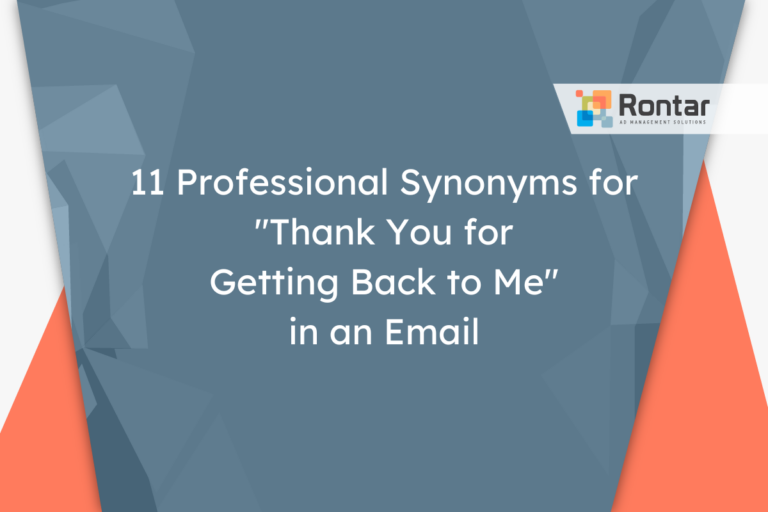12 Professional Ways to Say “Thank You for the Information” in an Email

Writing emails is a big part of work life, and saying “Thank you for the information” is often necessary. But using the same phrase over and over can get boring.
This article provides twelve different ways to express your gratitude for sharing information in a professional email, each with its own example. By mixing up your language, you can keep your emails fresh and show your appreciation more effectively.
Is It Professional to Say “Thank You for the Information”?
Yes, saying “thank you for the information” is professional, formal, and polite. This phrase fits well in various business and professional settings. It’s a respectful way to acknowledge the effort someone put into providing you with data, insights, or updates.
You can use this phrase with different types of recipients, such as colleagues, managers, clients, or any professional contacts. It works across multiple communication channels, including emails, formal letters, and even work chats.
Here is a simple example of using this phrase in an email:
Dear Ms. Thompson, I received the documents you sent over regarding the project. Thank you for the information; it was very helpful for understanding the next steps we need to take. Best regards, Mark Anderson
Pros:
- Shows appreciation and acknowledges the recipient’s effort.
- Keeps the tone of the conversation professional and respectful.
- Can be used in a wide range of professional scenarios.
Cons:
- May seem repetitive or less personal if overused in communications with the same person.
- Lacks specificity about which information was helpful or how it was used.
While “thank you for the information” is a suitable and professional phrase, you might want to use an alternative occasionally. Doing so can add variety to your emails and make your appreciation seem more personal and detailed. Looking for a synonym or an alternative phrase can also help tailor your message more closely to the specific situation or relationship you have with the recipient.
12 Other Ways to Say “Thank You for the Information” in an Email
Expressing gratitude can be done in many ways, especially in professional emails. Here are twelve polished alternatives to “Thank you for the information.”
- Thank you for sharing
- Thanks for the update
- I appreciate the information
- Thanks for letting me know
- Thanks for keeping me in the loop
- I appreciate you letting me know
- Appreciate the insights
- Thanks for the details
- I appreciate you taking the time to tell me
- Thank you for your input
- Many thanks for the information provided
- Thank you for your diligence in sharing this
1. Thank you for sharing
This phrase is a more casual synonym for expressing gratitude. It feels less formal than “Thank you for the information” but still maintains a tone of professionalism. This makes it versatile for both emails and verbal communication.
It is suitable for messages to colleagues or clients where the relationship is not strictly formal. This alternative can be used in emails, chat messages, or even in meetings. It brings a touch of personal appreciation without losing the professional touch.
Here’s a sample usage in an email:
Hi Alex, I just finished reviewing the documents you sent over. Thank you for sharing your findings with me; it really helps to have all the relevant information on hand. Best regards, Emily
2. Thanks for the update
“Thanks for the update” is a direct and informal way to acknowledge the receipt of new or additional information. It implies ongoing communication and is less formal than the original phrase.
This alternative works well in a business setting where updates are frequent. It’s ideal for emails to team members or colleagues within the same company. This phrase suggests a level of pre-existing familiarity and ongoing dialogue.
Example of use in an email:
Hello Team, Thanks for the update on the project's progress. It's great to see everything moving forward as planned. Warm regards, Jordan
3. I appreciate the information
This is a straightforward and sincere way to express gratitude. Although it is similar in formality to the original, it adds a personal touch by emphasizing appreciation.
It is suitable for more formal emails or when communicating with higher-ups and new clients. It conveys respect and professionalism, making it a strong choice for official correspondence or when dealing with sensitive information.
Here’s how you might use it in an email:
Dear Mr. Thompson, I've received the report on last quarter's sales. I appreciate the information; it will be invaluable for our upcoming strategy meeting. Sincerely, Nicole
4. Thanks for letting me know
This phrase is somewhat informal and suggests a level of comfort between the sender and recipient. It’s more personal than “Thank you for the information” and carries a sense of gratitude for being kept in the loop.
It’s perfect for conversations with colleagues or clients you have established relationships with. This alternative is excellent for emails but can also be used in instant messages or casual reports. It’s particularly effective in situations where the information shared has immediate relevance or requires action.
Example:
Hi Samantha, Thanks for letting me know about the change in the meeting schedule. I'll adjust my plans accordingly. Cheers, Derek
5. Thanks for keeping me in the loop
This phrase conveys gratitude for being included in communications or decisions. It’s slightly informal and suggests that the sender values transparency and ongoing updates.
This phrase is great for using with teammates or peers to express appreciation for ongoing updates or decisions that affect the team. It is well-suited for emails, especially in a collaborative work environment where teamwork and project updates are common.
Here’s an example of its use:
Hello All, I wanted to express my gratitude for the continuous updates. Thanks for keeping me in the loop during this project; it really makes a difference. Best, Liam
6. I appreciate you letting me know
This variant adds a personal touch, emphasizing the appreciation for the sender’s action. It’s slightly more formal than some alternatives, striking a balance between personal and professional communication.
This phrase is ideal for interactions with colleagues and external contacts when you want to thoughtfully acknowledge receipt of information. It also fits well in emails where acknowledging the effort of sharing information is as important as the information itself.
An email example:
Hi Clara, The heads-up about the client's feedback was incredibly helpful. I appreciate you letting me know so we can address their concerns promptly. Kind regards, Tom
7. Appreciate the insights
This phrase is direct and carries a professional, yet personal tone. It’s less formal than the original but effective in showing gratitude for specific advice or detailed information.
It’s especially suitable for emails or messages where you’re thanking someone for their expert opinion or analysis. This alternative fits well in professional environments where the exchange of insights and feedback is encouraged.
For example:
Hi Maya, After reviewing the market analysis you provided, I appreciate the insights. They will be crucial for our strategy development. Regards, Evan
8. Thanks for the details
This phrase is straightforward and informal, suitable for when you’re acknowledging the receipt of detailed or complex information. It implies a friendly acknowledgment without being overly formal.
It is best used in situations where the information shared includes many specifics or when responding to a request for clarification. This makes it perfect for emails to colleagues or in situations where a more casual tone is acceptable.
Here’s how it could be written in an email:
Hey Jordan, Thanks for the details on the upcoming project timelines. It helps to have a clear picture of what's expected. Best, Alex
9. I appreciate you taking the time to tell me
This phrase emphasizes the effort the sender took to share information, making it a more personal and heartfelt thank you. It’s on the more formal side, suitable for professional settings.
This alternative is excellent for emails to mentors, supervisors, or anyone who has gone out of their way to provide you with detailed information or guidance. It’s also fitting for situations where the information provided required significant effort to compile or was provided swiftly in response to a request.
Example:
Dear Professor Hughes, I appreciate you taking the time to tell me about the research opportunities in your department. It has given me much to consider for my future studies. Sincerely, Olivia
10. Thank you for your input
This is a polite and formal way to acknowledge someone’s contribution or feedback. It’s suitable for professional settings where you want to express gratitude for someone’s advice or opinion.
This phrase is useful in situations where you’ve asked for feedback, advice, or a review and wish to thank the person for their contributions. It is perfect for emails to colleagues, mentors, or clients who have provided valuable insights.
Example email:
Hi Ethan, Your feedback on the draft proposal was invaluable. Thank you for your input; it has significantly improved the document. Best wishes, Sophie
11. Many thanks for the information provided
This phrase is a bit more formal and expresses a deep level of gratitude. It’s appropriate for emails where the information received was particularly useful or required effort to gather.
It’s especially fitting for formal communications, whether with higher-ups, new clients, or external partners. This alternative shows appreciation for the sender’s effort in providing comprehensive information.
Here’s a sample email:
Dear Dr. Martinez, Many thanks for the information provided regarding the new health protocols. Your detailed explanation has clarified many of our concerns. Kind regards, Vanessa
12. Thank you for your diligence in sharing this
This phrase highlights the thoroughness and care the sender took in providing information. It’s a formal expression of gratitude, suitable for professional and detailed communications.
This alternative is particularly well-suited for emails to individuals who have gone above and beyond in providing detailed, accurate, or timely information. It conveys a deep appreciation for their effort and dedication.
Example:
Hi Leonard, Your comprehensive update on the project's status has been incredibly helpful. Thank you for your diligence in sharing this; it ensures we all stay on the same page. Warm regards, Fiona
Final Thoughts
Choosing the right way to say “Thank you for the information” in your emails can make a big difference in how your message is received. The twelve alternatives provided offer a range of options, from formal to informal, ensuring you can find the perfect fit for any situation. Using these phrases can help keep your emails interesting and show that you genuinely appreciate others’ efforts. So, the next time you need to express gratitude in an email, consider trying one of these alternatives to make your message stand out.






